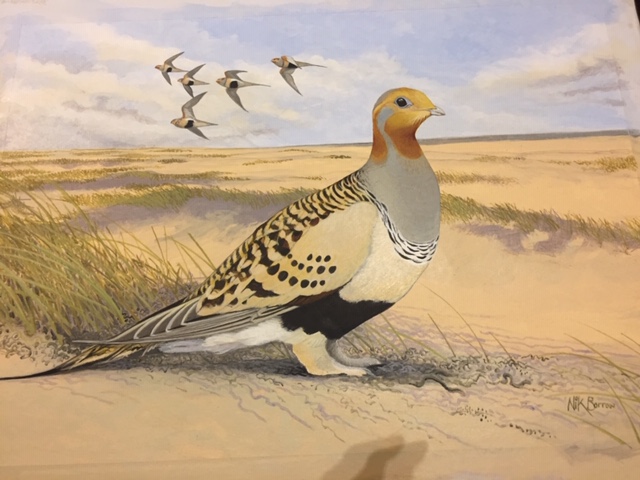Pallas's Sandgrouse Syrrhaptes paradoxus
Pallas's Sandgrouse illustration on the front cover of The Birds of Lincolnshire (2021); painting © Nik Borrow.
This enigmatic species occurred in unbelievable numbers in the late 19th century, since when it has not been recorded in the county. These immense numbers are unthinkable today and, even more incredible, there were also breeding attempts in Britain: clutches of eggs and young were found in 1888 and 1889. It seems unlikely we shall see such spectacular movements again.
1863
The first record was of a flock of 40-50 at Saltfleetby at the end of April 1863. At least 24 of these were shot, but survivors remained until July. One was found dead near Grimsby in the second week of May and two were shot from a party of 20 at Leake near Boston on May 25th. Others were shot in areas around Louth and Alford and in early August two of a flock of 20 arriving from the east at Huttoft were shot.
1888
A second invasion occurred in 1888 with 10-12 birds at Irby near Grimsby on May 18th, four at nearby Swallow on 22nd, five at Epworth on 23rd, two at Tetney on 25th and two were shot at Cawkwell near Louth on 28th. Birds continued to arrive during June with five near Lincoln on June 2nd, one shot at High Toynton, another found dead under telegraph wires along the Bourne to Spalding railway line and eight found poisoned in a field at Fulstow. One was at Cabourne Wold near Caistor on June 4th. Double figure flocks during May-June were noted as follows: 26 at Tetney in late May; 20-30 at Asserby near Alford for several days until June 9th; 21 at Horkstow on June 14th; seven at Brumby Common on June 15th increasing to 14 from June 17th-July 9th; 20 at Humberston June 18th-30th; 15 at Tetney in late June. Several small parties were reported at Authorpe near Louth on July 8th and two were shot at Holbeach in mid-July where there were another two on July 28th; five were at Cuxwold near Caistor mid-August. Large numbers continued to be recorded later in the summer and autumn with 40 were at Mablethorpe on August 30th; 20 at North Cotes on September 13th; five at Tetney October 3rd; 20 at Goxhill on October 23rd; 40 at Grainthorpe on November 11th.
1889
The totals recorded in 1888 were eclipsed by a very large flock of around 100 birds that wandered the sand dunes between North Somercotes and Saltfleetby from the last week of January to the end of March! There were also 30 on the north Wolds and three at Ingoldmells in late January. The last records of 1889 were of five at Brigg on May 4th increasing to 10 by July 27th.
1890
There was a smaller influx in 1890 that was less well documented. Eight were at South Killingholme on May 24th and a flock of 30 occurred "on the marshes of the Humber" but no dates were recorded.
1899
The last influx of the era occurred in 1899 when 30 were recorded on the north Wolds from late February to March 25th, a solitary bird remaining until May 19th. Two were shot from a flock of 13 on March 16th.
Arguably one of the most sought-after rarities for every British birder, by and large these are birds from a bygone era. What a sight these birds must have been for our Victorian forebears. This is more than evident from BBRC statistics – 6848 records prior to 1949, only 7 since 1950. These were as follows: one at Stodmarsh NNR (Kent) Sept 6th; three in 1969: Foula (Shetland) May 26th-31st; two in Northumberland, a male shot at Seahouses September 5th and another at Elwick Sep 6th (In Finland that year there were 4-6 birds in May and singles in May and June in The Netherlands); two on the Isle of May on May 11th 1975; one on Shetland May 19th-Jun 4th 1990.
(Account as per new Birds of Lincolnshire (2021), included September 2022)


